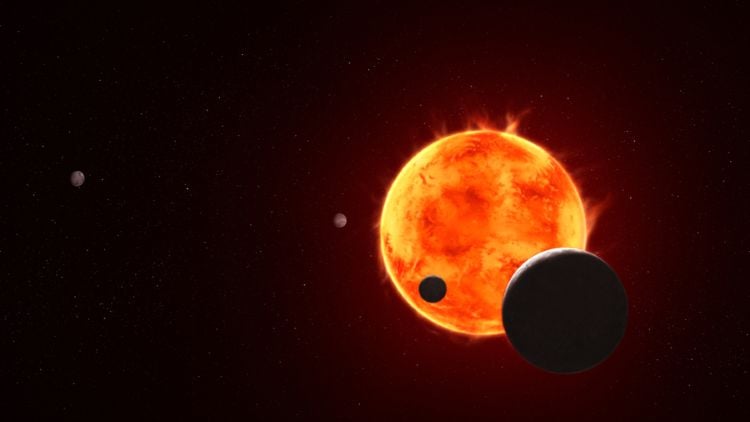Science
Scientists Explore Biosignatures of Microbes in Exoplanet Atmospheres

Researchers are making strides in the search for extraterrestrial life by investigating the potential for detecting microbial biosignatures in the atmospheres of exoplanets. A recent manuscript presented by a team of scientists explores how these biosignatures could be identified in the clouds of distant worlds, which could significantly enhance methods for finding life beyond Earth.
The study involves laboratory experiments with seven aerial microbial strains collected from Earth’s atmosphere. These include strains such as Modestobacter versicolor, Roseomonas vinacea, Micrococcus luteus, Massilia niabensis, and Noviherbaspirillum soli, as well as Curtobacterium aetherium and Curtobacterium oceanosedimentum. Using spectroscopy, the researchers analyzed the light reflected off these samples to determine if their unique spectral features could indicate the presence of biosignatures in exoplanetary atmospheres.
The findings revealed that each microbial strain exhibited distinct biosignatures, suggesting that these could potentially be used to identify signs of life within exoplanet clouds. The researchers concluded, “Here, we present an additional path for searching for life on Earth-like exoplanets: the search for biopigments as signs of life in clouds.” They emphasized the significance of UV-protective biopigment signatures as critical references for future missions aimed at detecting biosignatures in Earth-like exoplanets.
Several historical studies motivated this research, particularly the work of Dr. Carl Sagan and Dr. Ed Salpeter in 1976. They hypothesized about the potential for life in the clouds of Jupiter, suggesting the existence of various organisms adapted to specific ecological niches within its atmosphere. Their theoretical models proposed four categories of organisms: “Sinkers”, “Floaters”, “Hunters”, and “Scavengers.” This foundational work laid the groundwork for contemporary explorations into extraterrestrial life.
Another key driver for this study is the upcoming Habitable Worlds Observatory (HWO), a planned space telescope set for launch in the 2040s. HWO aims to utilize spectroscopy to analyze 25 habitable exoplanets for biosignatures, which could include the microbial biosignatures identified in this study. In addition to exoplanet research, HWO will focus on galaxy growth, star formation and evolution, and various solar system objects.
The capabilities of current space observatories, such as NASA’s James Webb Space Telescope (JWST), have already proven instrumental in studying exoplanet atmospheres. For instance, JWST has detected water, carbon dioxide, and carbon monoxide in the atmosphere of WASP-39 b, located approximately 700 light-years from Earth, and found quartz particles in the high altitudes of WASP-17 b, roughly 1,324 light-years away. Most recently, JWST published findings concerning the atmosphere of TRAPPIST-1 e, an Earth-sized exoplanet situated in its star’s habitable zone. Results from these studies did not confirm the presence of a definitive atmosphere around TRAPPIST-1 e but indicated that future research could provide clearer insights.
The TRAPPIST-1 system, located about 41 light-years from Earth, consists of seven known Earth-sized planets, three of which orbit within the habitable zone. It is speculated that all seven planets are tidally locked to their host star, similar to how Earth’s moon is locked to our planet.
As this research progresses, the implications for our understanding of life in the universe could be profound. The exploration of biosignatures in exoplanet atmospheres and clouds opens new avenues in astrobiology, with the potential to reshape our knowledge of life’s existence beyond Earth. Scientists are poised to make groundbreaking discoveries in the years ahead, as they continue to investigate the intricate relationship between microbial life and the vastness of space.
-

 Science2 weeks ago
Science2 weeks agoIROS 2025 to Showcase Cutting-Edge Robotics Innovations in China
-

 Politics2 weeks ago
Politics2 weeks agoJudge Considers Dismissal of Chelsea Housing Case Citing AI Flaws
-

 World2 weeks ago
World2 weeks agoBravo Company Veterans Honored with Bronze Medals After 56 Years
-

 Top Stories2 weeks ago
Top Stories2 weeks agoIndonesia Suspends 27,000 Bank Accounts in Online Gambling Crackdown
-

 Lifestyle2 weeks ago
Lifestyle2 weeks agoStone Island’s Logo Worn by Extremists Sparks Brand Dilemma
-

 Sports2 weeks ago
Sports2 weeks agoMel Kiper Jr. Reveals Top 25 Prospects for 2026 NFL Draft
-

 Health2 weeks ago
Health2 weeks agoStartup Liberate Bio Secures $31 Million for Next-Gen Therapies
-

 Health2 weeks ago
Health2 weeks agoTop Hyaluronic Acid Serums for Radiant Skin in 2025
-

 World2 weeks ago
World2 weeks agoHoneywell Predicts Record Demand for Business Jets Over Next Decade
-

 Sports2 weeks ago
Sports2 weeks agoYamamoto’s Mastery Leads Dodgers to 5-1 Victory in NLCS Game 2
-

 Politics2 weeks ago
Politics2 weeks agoNew Jersey Voters Urged to Register Ahead of November Election
-

 Lifestyle2 weeks ago
Lifestyle2 weeks agoMary Morgan Jackson Crowned Little Miss National Peanut Festival 2025









